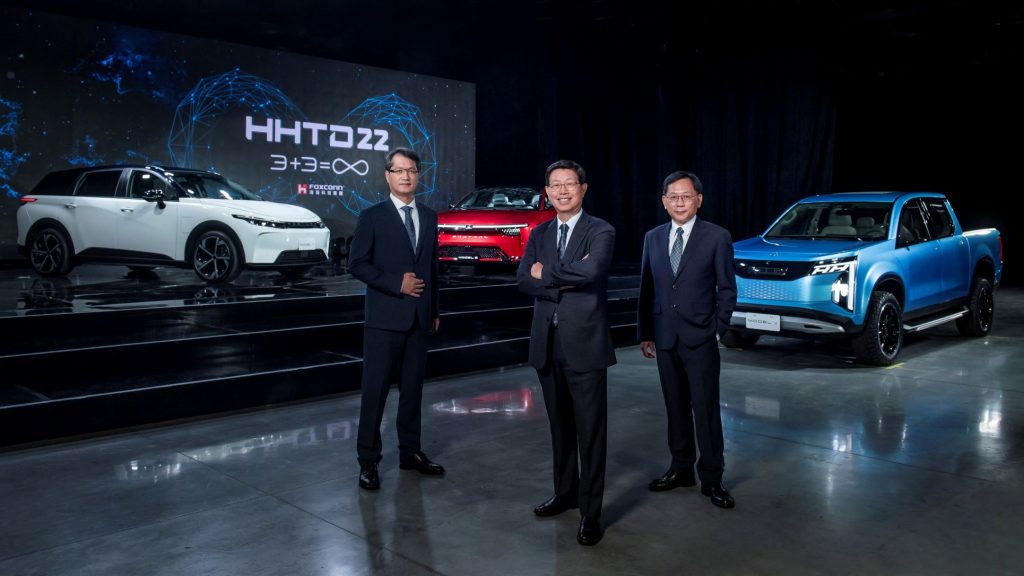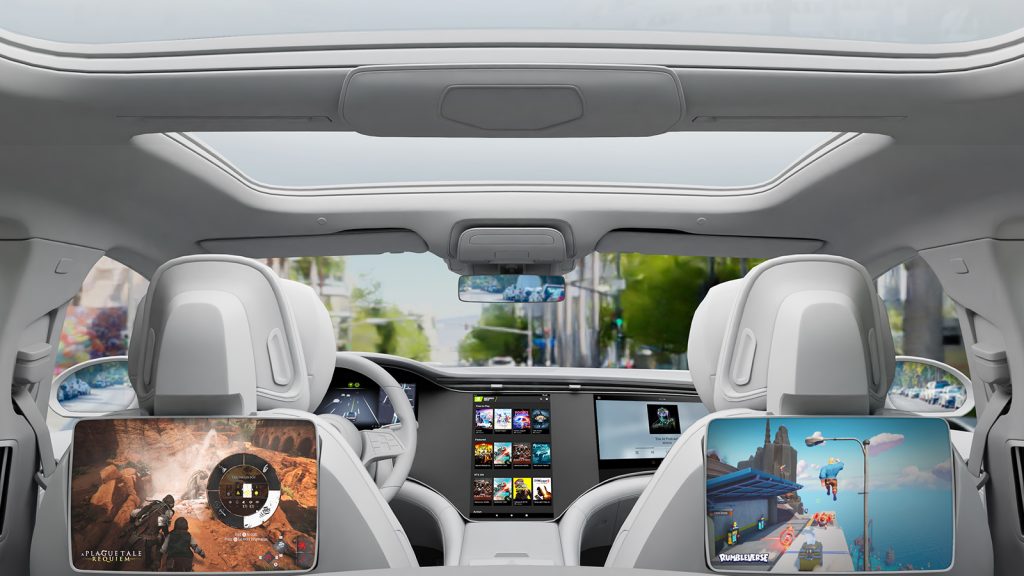
At CES 2023, the big news from Nvidia today was that Hon Hai Technology Group (Foxconn) will manufacture Nvidia’s Drive Orin computers for the global automotive market and integrate the Nvidia Drive Hyperion sensor architecture for its EV fleets. In the manufacturing metaverse, Mercedes-Benz will implement a digital-first approach to production, designing its next-generation factories with Nvidia Omniverse. On the increasingly important differentiator of improved passenger experience, Nvidia announced that GeForce NOW will stream its vast library of games to cars, with Hyundai Motor Group, BYD, and Polestar being the first automakers to offer an Nvidia cloud gaming service.
The Foxconn strategic partnership to develop automated and autonomous vehicle (AV) platforms. Foxconn will be a Tier 1 supplier producing electronic control units (ECUs) based on Nvidia Drive Orin for the global automotive market, and Foxconn-manufactured electric vehicles (EVs) will feature Drive Orin ECUs and Drive Hyperion sensors for automated driving capabilities.
“This strategic cooperation with Nvidia strengthens the intelligent driving solutions Foxconn will be able to provide,” said Eric Yeh, Senior Director of the Software Development Center at Foxconn. “Together, we are enabling the industry to build energy-efficient, automated vehicles. This is a well-considered partnership that leverages unique strengths on each side in the pursuit of innovative EV development and opportunities.”
The partnership with Foxconn will allow Nvidia to further scale its efforts and meet growing industry demand as more transportation leaders select Drive Orin for intelligent vehicles. In addition, by building EVs on the Drive Hyperion-qualified sensor set, Foxconn will speed its time-to-market and time-to-cost strategies.
“Our partnership with Foxconn will provide OEMs developing intelligent driving solutions with a world-class supplier that can scale for volume manufacturing of the Nvidia Drive Orin platform,” said Rishi Dhall, Vice President of Automotive at Nvidia. “Foxconn’s decision to also use the Drive Hyperion sensor suite for its EVs will help accelerate their path to production without compromising safety, reliability, or quality.”
In October in Taipei, Taiwan, Foxconn announced two, new self-developed concept prototype electric vehicles at its third annual Hon Hai Tech Day—the Model B crossover hatchback and the Model V pickup. It showcased the Model C production vehicle to be delivered to its brand customer in Taiwan this year while showcasing its key components of the EV supply chain such as electric power steering systems, solid-state batteries, silicon carbide power modules, and semiconductors. And it promoted the business model of contract design and manufacturing service for EVs through the next decade.
Nvidia’s Drive Orin system-on-a-chip achieves up to 254 TOPS (trillion operations per second) and is designed to handle the large number of applications and deep neural networks that run simultaneously in AVs. Drive Hyperion is a modular development platform and reference architecture for designing AVs. Combined, they serve as the brain and central nervous system of the vehicle, processing massive amounts of sensor data in real-time so autonomous vehicles can safely perceive, plan, and act.

On the manufacturing side, Mercedes-Benz announced at CES that it is taking the next step in digitizing its production process, using Nvidia AI and metaverse technologies, the automaker can create feedback loops to reduce waste, decrease energy consumption, and continuously enhance quality.
Mercedes-Benz has been working with Nvidia to develop software-defined vehicles, with its upcoming fleet to be built on Nvidia Drive Orin centralized compute with intelligent driving capabilities tested and validated in the Nvidia Drive Sim platform built on Omniverse. The latest announcement infuses AI and metaverse technologies even further into the Mercedes-Benz development process.
Mercedes-Benz plans to start production of its new dedicated platform for EVs at its plant in Rastatt, Germany, that currently manufactures the automaker’s A- and B-Class as well as the compact SUV GLA and the all-electric Mercedes-Benz EQA. Experts from the partners are setting up a “digital first” planning process for the plant that won’t disrupt the current production of compact car models at the site. This blueprint will be rolled out to other parts of the global Mercedes-Benz production network for more agile vehicle manufacturing.
Nvidia’s Omniverse is an open 3D development platform enabling customers to build and operate digital twins for industrial and scientific use cases. It’s based on universal scene description, allowing the construction of custom 3D pipelines to break down data silos and interact with a single-source-of-truth view of their aggregated simulations.
With Omniverse, Mercedes-Benz planners can access the digital twin of the factory, reviewing and optimizing the plant as needed. Every change can be quickly evaluated and validated in the virtual world, then implemented in the real world to ensure maximum efficiency and ergonomics for factory workers.
Additionally, Mercedes-Benz can synchronize plant locations anywhere in the world by connecting Omniverse with its in-house MO360 data platform. The capability streamlines operations across its global production network and enables over-the-air software updates to manufacturing equipment.

To enhance the passenger experience, Nvidia today announced that the high-performance GeForce NOW cloud gaming service will be coming to cars, first from Hyundai Motor Group, BYD, and Polestar. Hyundai Motor Group, which includes as standard Nvidia Drive in-vehicle infotainment systems across its Hyundai, Kia, and Genesis lineup, will include the service in select vehicle models. BYD, which is developing its vehicles on the Nvidia Drive platform, is working with Nvidia to bring the in-vehicle cloud gaming experience to the international automotive market. Polestar, which is also powered by Nvidia Drive centralized compute, will bring the cloud gaming service to its EVs.
The announcement expands Nvidia’s infotainment offerings, which include a suite of products and services aimed at improving the cockpit experience. Coupling Nvidia’s heritage in gaming and infotainment, GeForce NOW can stream a real-time, full, PC-gaming experience beyond desktops, laptops, and mobile devices into vehicles. It can enhance time spent charging EVs or riding in vehicles, enabling front-seat occupants to stream games while parked and rearward passengers if screens are available.
“Accelerated computing, AI, and connectivity are delivering new levels of automation, safety, convenience, and enjoyment to the car,” said Ali Kani, Vice President of Automotive at Nvidia. “The ability to stream popular titles from gamers’ libraries along with dozens of free-to-play games will bring the in-vehicle infotainment experience to new heights.”
GeForce NOW uses breakthrough low-latency streaming technology powered by GeForce servers in the cloud, enabling real-time gameplay. The service has more than 1000 titles, including A Plague Tale: Requiem, The Witcher 3: Wild Hunt, and Cyberpunk 2077 from leading PC game stores including Steam, the Electronic Arts app, Ubisoft, Epic Games Store, and GOG.com. It also includes many of the most popular free-to-play games like Fortnite, Lost Ark, and Destiny 2.
GeForce NOW is available from Nvidia in North America and Europe, and through GeForce NOW Alliance partners in other parts of the world.

